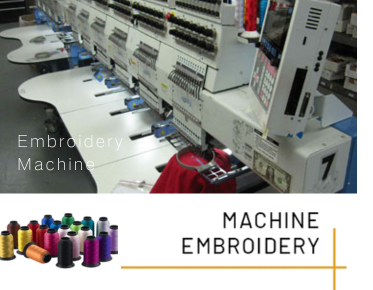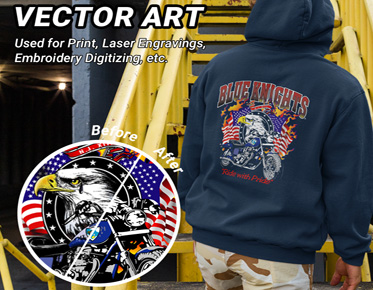Master the Art of Choosing the Correct File Format for Embroidery
Choosing the correct file format is crucial in embroidery. The right format ensures that your machine interprets your design with precision, allowing for the flawless execution of your creative vision. Without the correct format, you might encounter unexpected outcomes like uneven stitching, thread breakage, or misalignment of colors. These issues can lead to wasted time and materials, and they often require reworking the design from scratch. Whether you are a seasoned professional or a beginner, understanding embroidery file formats will save you time, effort, and frustration, ensuring a seamless stitching process every time.
Understanding Embroidery File Formats
At its core, an embroidery file is not just a simple image. It’s a set of instructions, essentially a blueprint, that guides the embroidery machine through the stitching process. While standard image files like JPG or PNG hold visual data, embroidery files contain critical information about how each stitch should be made—its type, placement, and order. This subtle yet critical difference is what makes embroidery files distinct, requiring a specific format that your machine can read and execute. By selecting the right format, you ensure that your machine knows exactly how to interpret your design, from the first stitch to the last.
Common Embroidery File Formats You Need to Know
Embroidery machines often require specific file formats to properly translate designs into stitches. Below are some of the most widely used formats:
● PES: The Standard for Brother Machines
PES is one of the most commonly used formats in embroidery, particularly for Brother machines. It offers robust support for a wide range of stitching types and design complexities, making it an excellent option for most projects. PES files also allow for the integration of multiple color changes within the design, offering greater flexibility. This format also ensures that the stitching layout remains intact, preventing errors during execution.
● DST: A Versatile Format for Many Machines
DST is compatible with a variety of embroidery machines, including those from commercial brands. Its widespread use makes it a go-to choice for professionals working on large, multi-need machines. This format excels at handling designs that require significant detail and precision, especially for industrial-scale embroidery. Because of its compatibility with many different machine brands, DST is often used in commercial and mass-production settings.
● EXP: Widely Compatible for Industrial Machines
The EXP format is ideal for industrial-grade machines and offers a high level of versatility. It allows intricate details and supports a large number of stitch types, making it suitable for both simple and complex designs. EXP files are commonly used in situations where design complexity is high, such as with logos or large-scale projects. Many embroidery professionals prefer EXP for its ability to handle large stitch counts without compromising on quality or accuracy.
● JEF: A Reliable Choice for Janome Machines
For Janome machine owners, JEF is the go-to format. It’s known for its excellent compatibility with these machines and its ability to handle detailed stitching with ease. JEF is particularly beneficial for smaller designs or projects that require fine detailing. The format also supports multi-color projects, making it versatile for a wide range of embroidery tasks.
Factors to Consider When Choosing a File Format
When selecting a file format, several factors must be considered to ensure the design will stitch out as expected. Here are a few key considerations:
● Compatibility with Your Embroidery Machine
Before anything else, the most important factor is whether your machine can read the format. Check your machine’s specifications to determine which formats it supports. Using an incompatible format could result in incomplete designs, or worse, machine errors that could cause permanent damage. Always verify compatibility to avoid potential issues.
● Design Complexity: Does the Format Support Detail?
Intricate designs require a format that can handle fine details. Opt for formats like PES or EXP, which are excellent for designs with complex stitching patterns. These formats allow the machine to read and execute even the smallest, most detailed elements with precision. If you are working on a simple design, however, less complex formats like DST might suffice.
● Stitch Types and Their Impact on Format Choice
Some formats are better equipped to handle specific types of stitches, such as satin stitches or running stitches. If your design involves intricate stitch types, be sure the format you select can accommodate them. Satin stitches, for example, require a format that ensures smooth, continuous lines, while running stitches may need a format that supports less density and more fluidity.
File Formats for Different Types of Projects
Different types of embroidery projects require different file formats to achieve the best results. Whether you are working on a simple monogram or a detailed logo, here’s how to choose the ideal format:
● Monogramming and Text-Based Designs
For text-heavy designs, formats like PES or JEF work well, as they preserve the clarity and legibility of letters. They also support various text sizes without distorting the design. Monogramming often requires precise alignment and clean, sharp letters, which these formats excel at. The ability to scale text without losing quality is essential, particularly for small lettering.
● Custom Graphics and Logos
Logos and custom graphics often involve multiple colors and intricate stitching, so formats like DST or EXP, which handle complex designs with precision, are the best choice. These formats preserve the exact stitch order and color changes necessary for a crisp, professional finish. Additionally, they offer flexibility with stitch types, allowing for optimal execution of logos with fine details.
● Multi-Color Designs
For multi-color projects, ensure that the format you choose can manage color changes efficiently. Formats like PES and EXP are ideal for such projects as they allow you to adjust and separate colors easily. They also prevent misalignment of colors, ensuring that each section of your design is stitched in the correct hue and sequence. Color management is critical for designs with intricate patterns, where each color needs to be perfectly placed.
How to Convert Between File Formats
Sometimes, you’ll find yourself needing to convert a design from one format to another, especially if you’re working with multiple types of machines.
● Manual Conversions: When to Use Them
Manual conversions are ideal when you need a quick fix. With embroidery software, you can easily convert a design to the appropriate format, ensuring the file matches the stitching specifications for your machine. This method is perfect for one-off conversions, though it may require additional adjustments to stitch density or color placement.
● Using Embroidery Software for Efficient Conversions
For bulk conversions or more intricate adjustments, embroidery software can save you time. Software such as Wilcom or Hatch offers a simple interface for format conversion while maintaining the integrity of the design. These programs allow you to make modifications to the design, such as adjusting stitch density or adding color changes, before converting the file to the correct format.
The Role of Stitch Types and Their Corresponding Formats
Stitch types play a pivotal role in determining which file format is most suitable for your design. Here's a breakdown:
● Satin Stitches vs. Running Stitches: Which Format Works Best?
Satin stitches, known for their smooth finish, work best with PES and EXP formats, which support their fine detail. These formats ensure that satin stitches are evenly spaced and create a clean, professional look. Running stitches, which are often used for borders or delicate lines, are ideal in formats like DST, which handle lighter, less dense stitching efficiently.
● How Different Stitches Affect Format Selection
When selecting a format, consider the types of stitches your design requires. Certain formats are optimized for specific stitch types, so choosing the wrong one could lead to uneven stitching or design distortion. For instance, designs that feature a high volume of fill stitches require formats that support intricate fill patterns, while outline-heavy designs may fare better with formats like JEF or DST.
Tips for Optimizing Your Files Before Embroidering
Before you hit "start" on your embroidery machine, ensure your files are optimized for the best results:
● Clean-Up Designs: Trimming Unnecessary Elements
Eliminate any extraneous elements in your design that might interfere with stitching. Whether it’s unnecessary background elements or unwanted colors, trimming these will prevent your machine from misinterpreting instructions. This step also minimizes the risk of errors or unnecessary stitch overlays, leading to a cleaner final product.
● Adjusting for Size and Scale in the Chosen Format
Ensure that your design is correctly scaled to fit within the dimensions of your embroidery hoop. Some formats may distort when resized, so always check for consistency before beginning. If resizing is necessary, it’s important to ensure that stitch density remains appropriate and that the design does not lose its intended proportions.
Troubleshooting Common Embroidery File Format Issues
Even with the perfect file format, issues may arise. Here are some common problems and their solutions:
● Stitches Not Appearing as Expected
This can happen if the file format does not support certain stitch types or details. To fix this, convert the design into a more suitable format like PES or EXP, which can handle detailed stitch types. Always double-check that your chosen format is compatible with the complexity of your design before starting the embroidery process.
● Colors Misaligned or Inaccurate
Misalignment of colors can be fixed by adjusting the color settings in your software before transferring the file to the machine. Make sure to match the thread color codes precisely. This will prevent discrepancies between the design on-screen and the final stitched result, ensuring color accuracy throughout the design.
Future Trends: What’s Next for Embroidery File Formats?
As technology evolves, so too do the tools and file formats used in embroidery.
● Evolving Technology and Format Advancements
We can expect further innovations that allow for more sophisticated stitching capabilities, enhanced machine compatibility, and faster processing times for large-scale projects. Emerging technologies may enable more seamless file format conversions and support for more complex designs that push the boundaries of embroidery.
● Adapting to New Machine Capabilities
As embroidery machines grow more advanced, future file formats may incorporate features like 3D designs or automated adjustments, further enhancing the creative possibilities available to designers. These advancements will allow for greater flexibility and precision, opening the door for more innovative embroidery techniques.
Choosing the right embroidery file format is an art in itself. Armed with this knowledge, you can master the craft of embroidery, ensuring your designs are executed with precision, flair, and efficiency.


.png)
